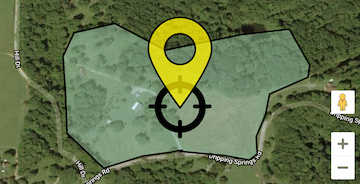Ladino Clover-Trifolium repens

By Kent Kammermeyer, Senior Wildlife Biologist
Three types of white clovers are currently available to deer managers: small leaf types (often called white Dutch clover or common white clover), intermediate leaf types, and large or giant leaf types called ladino white clover. The large types (crossbred for high production) trace to ecotypes originally cultivated in Northern Italy and later all around the world. There is a widespread misconception that ladinos are cattle clovers not suited for deer. This is false; tall long stemmed clovers are fine for deer since the leaf is the main forage target anyway (not the stem) and tall growth makes them more competitive with grassy weeds. Ladinos are long-lived perennials in the northern U.S. but short-lived perennials or annuals in the Deep South. As such, including other improved intermediate white clovers (such as Durana and Patriot), they are arguably the best high quality, low maintenance highly productive perennial forages available to deer managers in the U.S. (the others are alfalfa, red clover and birdsfoot trefoil). Ladinos are characterized by very leafy plants 8 to 12 inches tall that spread by stolons (runners) and form shallow roots at nodes. Leaves are smooth (not hairy) and usually marked with a white "V". White flowers are clustered into heads and seed are extremely small.Ladino is adapted throughout the eastern U.S. from Canada south through Florida and westward until production becomes limited by low rainfall in the Great Plains, picking up again in the Northwest. Although it is not productive on droughty soils, it will survive considerable dry weather. Once established, ladino is tolerant of moderate soil acidity. It is tolerant of wetter soils and is highly responsive to potassium fertilizer. Under ideal conditions, ladinos can produce over 10,000 lbs/acre/year of high quality forage.
Establishment/Mixtures
Ladino grows well in association with cool season perennial grasses such as perennial ryegrass, bluegrass, velvetgrass and timothy. It will not do well with fescue, orchardgrass, bermudagrass or bahiagrass. In most of the U.S., I recommend mixing ladino clover with one of the annual grains such as wheat, rye, or oats because the above cool season perennial grasses are generally not good deer forage except in the North. Inoculation (live Rhizobium bacteria that helps clover fix nitrogen) is critical to seedling survival and soil pH is critical to inoculant survival. Buy pre-inoculated ladino with the clay/lime coating and be sure soil pH is above 6.0 at planting. Broadcast rate in the South is 5 lbs/acre ladino mixed with 7 lbs/acre red clover and 50 lbs/acre wheat (or rye or oats) planted in September/early October. An alternative month is late February/early March for ladino/red clover/oats mixture. In the far North, plant pre-inoculated ladino (5 lbs/acre) with red clover (7 lbs/acre) and perennial ryegrass (20 lbs/acre) or timothy (5 lbs/acre). Plant ladino mixes in September or April in the North. Ladino can be mixed with red clover and frost-seeded in late winter. Fertilize according to soil test. In lieu of a soil test, keep nitrogen levels low (< 60 lbs/acre) to avoid grass competition and apply plenty of phosphorus and potassium (ex:300 lbs/acre of 19-19-19 or 300 lbs/acre8-24-24). Ladino clover production will be slow the first fall, but high production will begin in early spring and continue through October or November for several years thereafter. While the Ladino starts slowly (developing a root system and nodules to fix its own nitrogen), the red clover and the grasses in the recommended mixes provide immediate forage production for deer in the first fall. These companion plants also act as a nurse crop by diverting grazing pressure away from new ladino seedlings.
Management/Varieties
Management of ladino clover is dependent on grass management and weed control. Ladino planted with perennial grasses should be mowed frequently (2 or 3 times per summer) with the final mowing in late August. Fertilizer should be applied once per year in September with 300 lbs/acre of 0-20-30. The same management technique is used for ladino planted with annual grasses but fewer mowings maybe needed, depending on weed competition. If everything goes well, the second year stand should be a mixed stand of ladino and red clover with the third year being pure ladino. If wild grasses (crabgrass, johnsongrass, bermudagrass, bahiagrass, foxtail, fescue or ryegrass) become a problem competing with clover, Poast grass-selective herbicide (mixed with crop oil) can be sprayed when grasses are 6-8 inches tall to remove grasses without damaging the clover stand. Apply when grasses are vigorously growing. Cultivars in the U.S. which are in widespread use include California Ladino, Osceola, Regal, Tillman, Advantage, Will, Tripoli, Alice and Patriot (a Pennington hybrid). I have used all of the above varieties in north Georgia and all produce well and are utilized heavily by deer. Both Osceola and Patriot are noted for their persistence. New ladino clover blends include Rackmaster Supreme Clover/Rye Blend, Rackmaster Ultimate Perennial Mixture, Rackmaster Refuge Mixture, and Rackmaster Clover Blend. New cultivars and hybrids of ladino and medium leaf white clovers, which are even more persistent, should be available in a few years.
In my opinion, using a perennial for deer plots is the way to go! Ladino clovers fit the bill for a productive, high quality perennial plant that is tops on the deer preference list at 25-30% protein and 70% digestibility.

